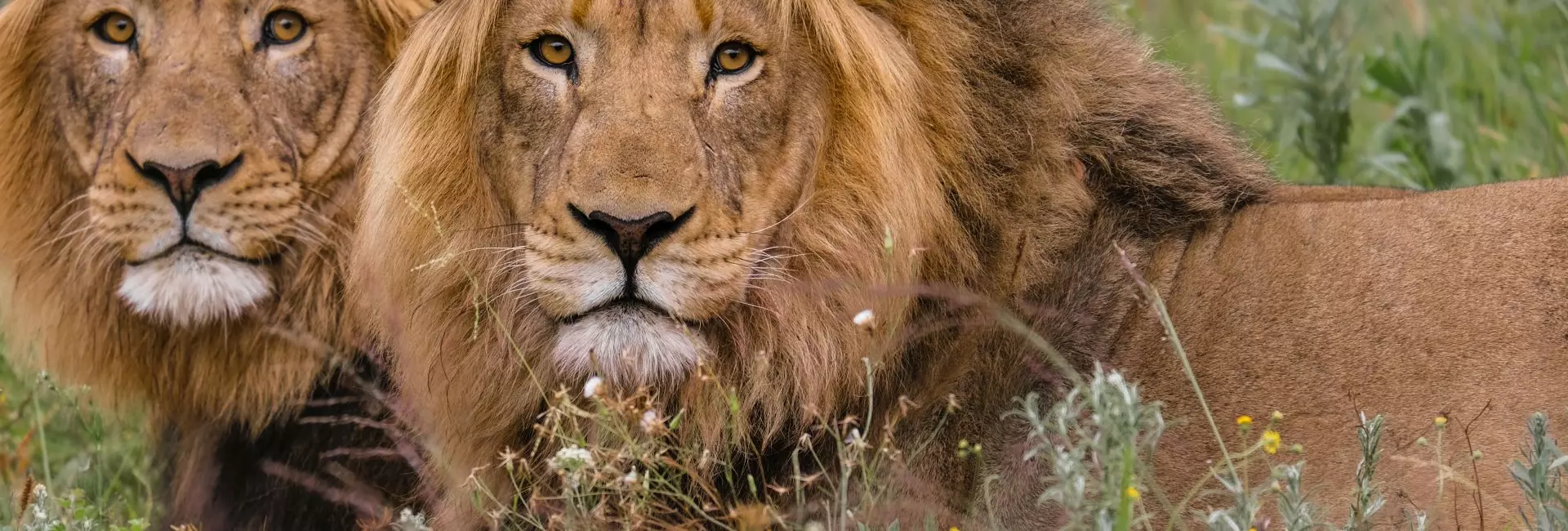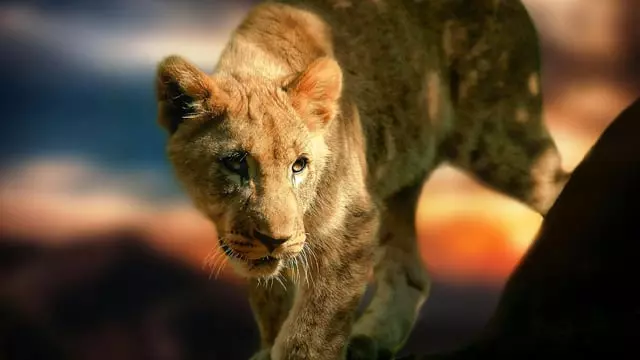
Lions
Lion Conservation
Lions are apex predators, revered for their strength and are a symbol of Africa, making them the stars of the big cat world. Yet, their conservation status teeters on the edge of endangerment, and with population numbers plummeting, lion conservation is now more important than ever.
Lion conservation projects aim to tackle the main threats harming lions, such as habitat loss, human-lion conflict, and poaching. With other African species, including the other 'Big 5' animals, facing similar issues, The Great Projects offers a variety of volunteer projects where you'll encounter lions as part of your daily activities. On our 'Big 5' conservation projects, volunteers help monitor lions, assess feeding habits, pride structure, predator vs prey ratios and sometimes help with translocations & collaring of lions. Other projects, such as the Namibia Wildlife Sanctuary and the SanWild Sanctuary & Reserve, have several lions rescued from human-wildlife conflict, circuses, and trophy-hunting farms. Here, volunteers help to feed the lions, occasionally spot clean enclosures and assist veterinary staff when necessary. On the Shamwari Conservation Experience, volunteers even receive a behind-the-scenes tour of the acclaimed Big Cat Sanctuary run by the Born Free Foundation - a front-runner for lion conservation efforts!

Projects Do More
14 - 84 Nights from $1,614.00 $1,372.00
Experience hands-on volunteering in Africa in the heart of the beautiful Namibian wilderness!
View project14 - 84 Nights from $2,154.00
Volunteer with the 'Big 5' and the Born Free Foundation in one of South Africa's finest game reserves.
View project14 - 84 Nights from $1,884.00
Assist in vital conservation efforts in South Africa, working to protect the iconic ‘Big 5’ and other priority endangered species.
View project7 - 84 Nights from $939.00
Join this 'Big 5' conservation project and help make a difference to the lives of the amazing animals that live here!
View project7 - 84 Nights from $1,209.00
Volunteer with the 'Big 5' on one of the country’s most diverse wildlife reserves.
View project
14 - 84 Nights from $1,614.00 $1,372.00
Volunteer with big cats, baboons, meerkats and more at this stunning wildlife sanctuary in Namibia.
View project7 - 56 Nights from $2,154.00
Luxury meets conservation at our brand-new 'Big 5' project! Experience wildlife rescue and rehabilitation missions in the home of Safari, South Africa.
View projectOn the Blog
Lion Information
Lions At A glance
Endangered Status
Vulnerable
Number remaining in the wild
23,000-39,000
Endemic Region
Africa And Some Parts Of Asia
The IUCN Red List documents the conservation status of lions as vulnerable.
There are currently only 23,000-39,000 lions left in the world. Although they are not yet classified as endangered, the ongoing decline in lion populations and the persistent threats they face are significant causes for concern, emphasising the urgent need for lion conservation efforts.
The Asiatic lion subspecies is listed as endangered, with only a few hundred left and found solely in Gir Forest, India. At present, their numbers are low yet stable.
Lions face several threats that impact their populations and overall survival. These threats include:
- Habitat Loss: Lions have lost significant amounts of natural habitat due to human population growth. Many urban and agricultural areas have encroached on lion territories. This not only reduces the space available for lions to live and hunt but also fragments and isolates lion populations, making it difficult for them to find mates, leading to inbreeding.
- Human-Wildlife Conflict: Lions often come into conflict with humans when they prey on livestock. In retaliation, farmers and herders may kill lions to protect their animals and livelihoods.
- Poaching and Illegal Trade: Lions are targeted and killed for their body parts, such as bones, teeth, and claws, which are used in traditional medicine and as trophies. Lion bones are an in-demand product currently and are a substitute for rarer tiger bones.
- Decreased Prey Availability: Overhunting and competition from humans can lead to a decline in the populations of the lions' natural prey, such as antelope and zebras. Droughts and the effects of climate change can also reduce prey populations and increase competition for resources.
- Disease: Lions are susceptible to canine distemper virus and bovine tuberculosis, which can be transmitted from domestic animals. These diseases can cause significant mortality in lion populations.
- Inbreeding and Genetic Erosion: Small, isolated populations are at risk of inbreeding, which can lead to reduced genetic diversity and increased susceptibility to disease and other environmental changes.
- Lion Breeding Farms: Breeding farms for canned hunting, cub-petting, and the lion bone trade negatively impact lion populations and conservation efforts. Lion breeding for tourism diverts resources and attention away from wild lion conservation. The supply of lions to the canned hunting industry ends with them being shot, and many of the farms sell the lion bones, creating further demand and perpetuating the trade.
Efforts to conserve lions involve several key strategies to tackle the challenges the big cats face. These include establishing protected areas, enforcing anti-poaching measures, and reducing human-wildlife conflict. Community-based programs engage locals through education and incentives, while research by organisations and charities like Panthera, Born Free Foundation and LionAid protect lions and help guide conservation efforts. Strengthening laws, advocating for international protections like CITES, and restoring habitats are also crucial. Public awareness campaigns, educational programs, and global cooperation support these initiatives. Ethical lion volunteer projects support conservation by providing essential manpower for hands-on tasks, data collection, and community education while raising awareness and funding for conservation projects. Together, these efforts aim to secure a sustainable future for lions.
The illegal wildlife trade hurts lion populations by increasing the demand for lion parts, including bones and teeth, used in traditional medicine and as trophies. This trade results in higher rates of poaching and a decrease in the number of lions, posing a threat to their survival.
To ethically volunteer with lions and contribute to conservation efforts, avoid sanctuaries that prioritise tourism over conservation. Ensure the project has clear conservation goals, maintains high animal welfare standards with large natural enclosures, and does not allow practices like cub petting, hands-on contact or walking with lions. Ethical projects and true sanctuaries will involve work that directly benefits lions, such as habitat maintenance and behaviour observation, and support programs that educate volunteers and involve local communities.











